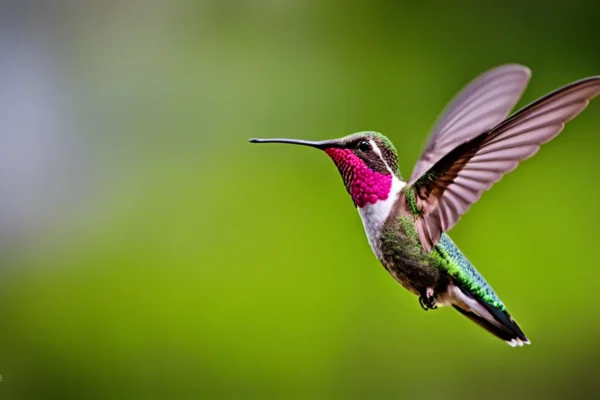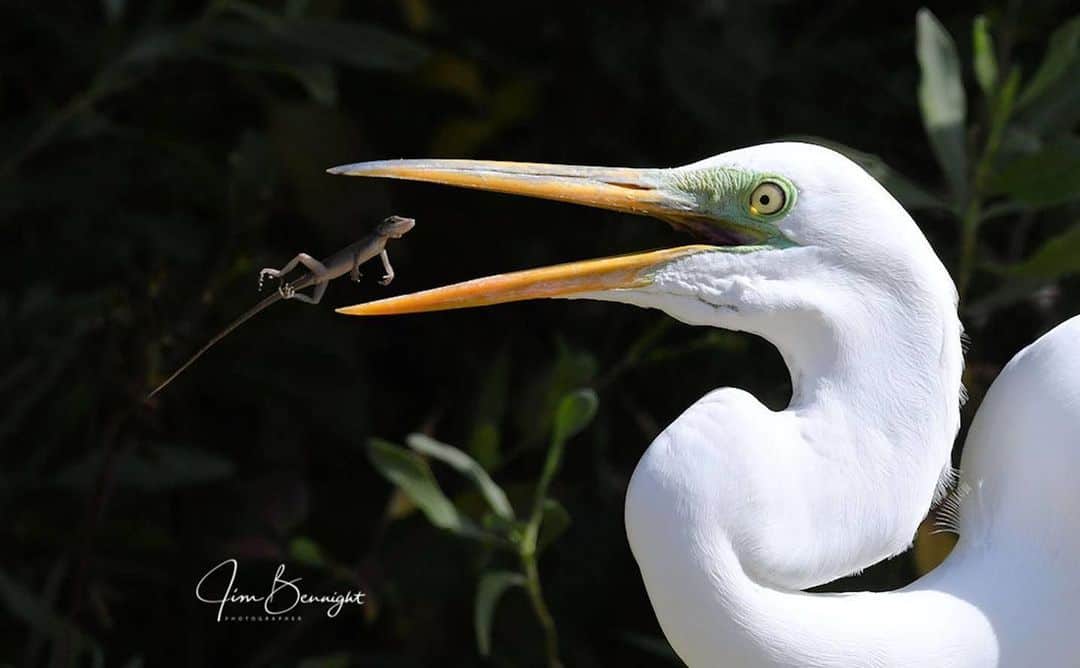Similar to a precious gemstone, a hummingbird’s eggs represent a remarkable marvel in the natural world. Despite their small size and flawless design, very few individuals have had the chance to observe a hummingbird’s eggs. This scarcity is due to the extreme difficulty in locating them. When viewed from below, these eggs appear as mere protrusions on branches. Seen from an overhead perspective, a canopy of leaves obscures them. Even from a lateral view, they resemble diminutive knots adorned with lichens, plant materials, and fibers woven together. While the 17 distinct species of hummingbirds that inhabit North America each construct slightly varied eggs within diverse environments, there are many shared characteristics among all hummingbird eggs.
Size of Hummingbird Eggs
The eggs of hummingbirds are truly minuscule, resembling small peas in size. Their dimensions range from 0.5 to 0.8 inches (1.3-2 cm) in length, weighing approximately 0.4 grams. To offer a comparison, these eggs are even smaller than jelly beans.
Frequency of Egg Laying
The frequency at which hummingbirds lay eggs varies based on species and food availability. While most species breed once or twice annually, certain types may breed up to three times within a year. The breeding season typically commences in late winter or early spring, extending to mid-summer. During this period, the female hummingbird lays one egg at a time, usually every two days.
Timing of Egg Laying
Hummingbirds strategically time their egg-laying to coincide with the blossoming of flowers, ensuring a sufficient food source for their offspring. The onset of the breeding season varies by location, often initiating in late winter or early spring and concluding in mid-summer.
Quantity of Eggs Laid Generally, hummingbirds lay two eggs in a single clutch. Nevertheless, some species have the capacity to lay up to four eggs per clutch. The female hummingbird methodically lays eggs one at a time, maintaining a two-day interval until the clutch is complete.
Nesting Locations
Hummingbirds exhibit versatility in choosing nesting locations, including tree branches, shrubs, and vines. Their nests incorporate materials like spider webs, moss, and lichens, held together by plant down and feathers. These tiny nests, roughly the size of ping pong balls, offer protection against predators and the elements.
Hatching Period
The incubation period for hummingbird eggs typically spans 14 to 16 days. Upon hatching, the chicks emerge blind and featherless, relying solely on their mother for warmth and safeguarding. The mother continues to nurture and feed her offspring until they are prepared to depart the nest, usually around three weeks after hatching.
How Long Does It Take for Hummingbird Eggs to Hatch?
The incubation period for hummingbird eggs typically lasts between 14 to 16 days. During this time, the eggs undergo development within the nest. After this span, the eggs hatch, revealing blind and featherless chicks. These newly hatched chicks rely solely on their mother for warmth, protection, and nourishment.
Color and Appearance of Hummingbird Eggs
Hummingbird eggs commonly exhibit a white coloration, although certain species’ eggs may possess subtle tints of blue or green. This color adaptation aids in concealing the eggs within the nest, providing a measure of defense against potential predators.
Characteristics of Hummingbird Eggs
Hummingbird eggs are small, oval-shaped, and comparable in size to a small pea. They measure approximately 0.5 to 0.8 inches (1.3-2 cm) in length and weigh around 0.4 grams. These eggs possess a smooth, rigid shell and are usually white, sometimes displaying a delicate bluish or greenish hue.
Consistency of Nest Locations
While hummingbirds may revisit the same general breeding area annually, they usually construct a fresh nest each breeding season. This practice serves to mitigate the accumulation of parasites and diseases within the nesting materials.
Post-Hatching Phase
Following the hatching of the eggs, the chicks emerge devoid of feathers and sight, with their eyes shut. They are heavily reliant on their mother for warmth, protection, and sustenance. The mother hummingbird assumes the responsibility of nurturing and feeding her offspring until they mature sufficiently to abandon the nest. This transitional phase usually spans approximately three weeks. After departing from the nest, the fledglings continue to receive maternal care for a brief period before becoming independent.
Encountering a Hummingbird Egg
Should you come across a hummingbird egg, it is crucial to refrain from disturbing the nest or the egg itself. Hummingbirds enjoy legal protection under federal law, rendering any disturbance of their nests or harm to their eggs illegal. In the event of concerns regarding the egg or nest’s well-being, it is advisable to consult local wildlife rehabilitators or conservation agencies for guidance.
Hummingbird Mating Process
The mating ritual of hummingbirds unfolds mid-air, featuring an awe-inspiring display of aerial maneuvers. The male hummingbird initiates courtship by engaging in an elaborate dance to attract a female partner. This ritual incorporates ascending and descending in a U-shaped pattern, hovering before the female, and executing diving motions. Once the female consents, the duo ascends into the sky, where the male utilizes his cloaca to fertilize the female’s egg.
Hummingbird nests are diminutive structures, often not exceeding the size of a ping-pong ball. Constructed primarily by the female hummingbird, these nests are woven from soft materials like moss and lichens, held together with the help of spider webs and various plant components. The interior of the nest is thoughtfully lined with plant down and feathers, contributing to warmth and safeguarding the eggs and fledglings within.
To attract hummingbirds to nest in your vicinity, you can offer nesting materials like cotton batting, pet fur, and feathers. Creating suitable nesting sites, such as sheltered tree branches or purpose-built hummingbird nest boxes, can also entice these tiny birds to make their homes in your area.
Distinctive Attributes of Hummingbird Nests
Across Species Diverse species of hummingbirds may construct nests with subtle variations. For instance, the Anna’s Hummingbird might incorporate man-made elements like string and paper into their nests, whereas the Black-chinned Hummingbird may build their nests atop thorny twigs to enhance protection against potential threats.
Nest Reuse and Consistency
Generally, hummingbirds do not reuse their nests. While they might revisit the same general breeding area each season, they typically embark on building a fresh nest anew. This practice helps prevent the accumulation of parasites and diseases within the nesting materials.
Frequently Asked Questions About Hummingbird Eggs Here are some commonly asked questions about hummingbird eggs:
What is a hummingbird egg? A hummingbird egg refers to the reproductive structure produced by a female hummingbird. It is a tiny, oval-shaped entity, usually white or adorned with a hint of bluish or greenish tint.
How large is a hummingbird egg? Hummingbird eggs are incredibly minute, measuring approximately the size of a small pea. Their dimensions range from 0.5 to 0.8 inches (1.3-2 cm) in length, with an approximate weight of 0.4 grams.
What is the smallest egg in the world? The bee hummingbird, recognized as the world’s smallest bird, also lays the tiniest egg. This egg is comparable in size to a pea and weighs a mere 0.05 grams.
Where is the optimal location to place a hummingbird nest? A hummingbird nest should be situated in a sheltered area, away from direct sunlight and strong winds. It’s essential to choose a location that affords easy access for the female hummingbird while ensuring protection against potential predators like cats.
What is the value of a hummingbird egg? Hummingbird eggs are safeguarded by federal law, rendering it illegal to disturb their nests or harm their eggs. Consequently, hummingbird eggs do not possess a monetary value and cannot be lawfully bought or sold.
Is a hummingbird egg the tiniest egg globally? Although hummingbird eggs are incredibly minuscule, they are not the smallest eggs in existence. The distinction of being the smallest egg belongs to the bee hummingbird, whose egg is approximately the size of a pea and weighs merely 0.05 grams.
In summary, hummingbird eggs are diminutive yet indispensable to the vitality and progression of these captivating birds. Typically, hummingbirds lay one or two eggs per clutch, and the eggs often showcase shades of white, sometimes accompanied by bluish or greenish undertones. Once the eggs hatch, the maternal care of the mother hummingbird persists until her chicks are prepared to venture beyond the nest. If you encounter a hummingbird egg, it’s crucial to refrain from disturbing it and seek guidance from local wildlife authorities.






